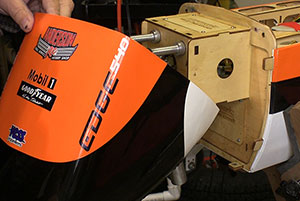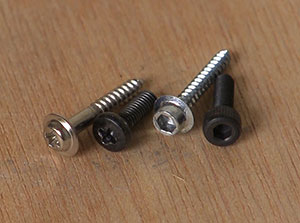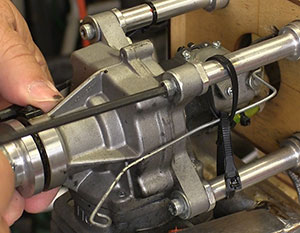|
|||||
FlyingRC.net is a
Veteran-Owned site.

 |
| There are too many important nuts and bolts to skip pulling the cowl now and then. Taking an hour or so to do this maintenance could save your plane! Click image to enlarge |
Tighten RC Nuts and Bolts
Prevent a stupid way to lose a plane
Text, photos and video by Tom Hintz
Posted – 12-15-2015
No matter how differently they may look all gas (and glow) engine airplanes share a pronounced tendency to vibrate. All of my gassers have wooden airframes that do a good job of soaking up much of the vibrations coming from the engine but there remains plenty of shaking to work on loosening bolts, nuts and screws. Though I do a lot to prevent fasteners from loosening in my planes, eventually something will start backing out. Since there are no parts that can fall out without at least putting my plane in jeopardy I think the more prudent approach is to check the %#$@ nuts and bolts occasionally!
Specialty Servo Fasteners
I hate the little Phillips headed mounting screws that come with servos. I also hate the Phillips screw that holds the servo arms to the output shaft. While building my first Aeroworks plane I noticed that they recommended a really nice socket head sheet metal screw for holding servos in place. The “#3 x 5/8 - Socket Head Washer Head Sheet Metal Screws” (See Micro Fasteners in the Resource section below) not only hold servos better, they are remarkably easy to install. The tip of these screws is very sharp and I seldom have to drill a pilot hole when installing a servo into a wooden mount. Add a drop of thin CA glue to the screw during final installation and they simply do not fall out. But, I do check them occasionally anyway.
Aeroworks also noted the M2.5 x 8 - Socket Head Cap Screws (Micro Fasteners) to replace the plain screws used to secure most servo arms to the output shaft. Once again the installation itself is far easier plus you can generate far more torque on the hex head screw when tightening than with the Phillips head originals. I add a drop of blue thread locker to these screws.
 |
 |
| I use these after-market screw and bolts (left) on my servos because they are easy to work with, hold fast and are cheap. the motor bolts (right) should be a no-brainer but check everything under the cowl! Click images to enlarge |
|
Preventive Installation
We use lots of wood screws in our planes usually screwed into wood that is used because of its light weight. That usually means the wood is also soft enough that threads can pull out easily. It is worth our efforts to lightly seat the screws once then remove them and add a drop of thin CA glue to the screw hole or the threads of the screw itself during final installation to harden the threads significantly.
Blue thread locker (removable type) should be applied to any bolt that screws into something else in the plane. Many of our engine standoffs have bolts coming from inside of the motor box that are hard to get at when the plane is assembled. Adding thread locker to these bolts should be a no-brainer. I use thread locker on any bolt that does not have a nut on it.
Speaking of nuts, aside from jam nuts on control surface turnbuckle linkages I replace every nut in my planes with insert style locking nuts. When I determine a size of nut (or other fastener) needed I will order a bag or two from Micro Fasteners to keep on hand. Before long I had nearly all of the sizes commonly used in RC planes in my nuts and bolts cabinet. Considering that they may well prevent a crash, this little cabinet and the inventory in it is a small investment.
Under the Cowl
The cowls that make so many of our planes look cool also hide a bunch of fasteners that could kill that plane if they fall out. Because of that I take my time going over all of the nuts and bolts under the cowl during final assembly. Then every once in a while I will pull the cowl to go over those nuts and bolts just to be sure. I may do this after every couple dozen flights but I try to make a point of it because long ago I had a motor mount screw back out and that allowed the engine to move slightly which helped it shed another bolt or two before it came out altogether. Seeing a cowl blow up as a glow motor blasts through it is spectacular, nearly as spectacular as me trying to guide a totally tail heavy “rest of the plane” back to the ground without hurting it much. I failed, it died and ever since I check nuts and bolts.
Video Tutor |
Checking nuts and bolts as well as all other fasteners in a RC plane would seem to be common sense maintenance but we hear of these kinds of issues all of the time. Even though I work at preventing such a failure I have “gone under the cowl” a number of times because something just did not seem right and nearly every time I found something loose. My Aeroworks 50cc Edge 540 used in this story has seen dozens of flights recently and was just due for a look. I am betting that many of you have a plane with a ton of flights on it that could also stand a look at the fasteners.
Resources
Micro Fasteners
Servo Mounting Screws - STW0310 - #3 x 5/8 - Servo Mounting - Socket Head Washer Head Sheet Metal Screws
Servo Arm Retaining Screws -SCM2508 - M2.5 x 8 - Socket Head Cap Screws
Have a comment on this story? –Email Me!
All Flyingrc.net written, photographic and drawn materials are property of and copyright by Tom Hintz and Flyingrc.net 2013-2020 Materials cannot be used in any way without the prior written permission of the owner.
Privacy Statement


